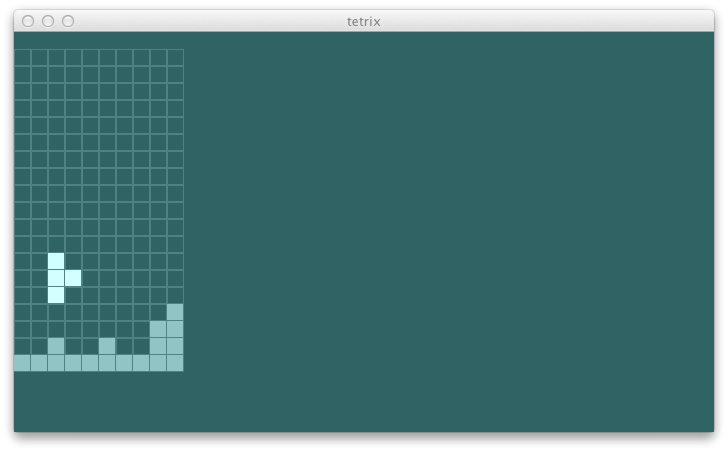tick
We have moveLeft and moveRight, but no moveDown. This is because downward movement needs to do more. Once it detects collision agaist the floor or another block, the current piece freezes at its place and a new piece gets dropped in.
First, the movement:
s2"""
Ticking the current piece should
change the blocks in the view, $tick1
"""
...
def tick1 =
tick(s1).blocks map {_.pos} must contain(exactly(
(0, 0), (4, 16), (5, 16), (6, 16), (5, 17)
)).inOrder
To get this test passed we can implement tick as using moveBy:
val tick = transit { _.moveBy(0.0, -1.0) }
Next, the new piece:
s2"""
or spawn a new piece when it hits something. $tick2
"""
...
def tick2 =
Function.chain(Nil padTo (18, tick))(s1).
blocks map {_.pos} must contain(exactly(
(0, 0), (4, 0), (5, 0), (6, 0), (5, 1),
(4, 17), (5, 17), (6, 17), (5, 18)
)).inOrder
The transit method already knows the validity of the modified state. Currently it’s just returning the old state using getOrElse. All we have to do is put some actions in there.
private[this] def transit(trans: Piece => Piece,
onFail: GameState => GameState = identity): GameState => GameState =
(s: GameState) => validate(s.copy(
blocks = unload(s.currentPiece, s.blocks),
currentPiece = trans(s.currentPiece))) map { case x =>
x.copy(blocks = load(x.currentPiece, x.blocks))
} getOrElse {onFail(s)}
Unless onFail is passed in, it uses identity function. Here’s the tick:
val tick = transit(_.moveBy(0.0, -1.0), spawn)
private[this] def spawn(s: GameState): GameState = {
def dropOffPos = (s.gridSize._1 / 2.0, s.gridSize._2 - 3.0)
val p = Piece(dropOffPos, TKind)
s.copy(blocks = s.blocks ++ p.current,
currentPiece = p)
}
Let’s see if this passes the test:
[info] Ticking the current piece should
[info] + change the blocks in the view,
[info] + or spawn a new piece when it hits something
timer
Let’s hook tick up to the down arrow key and a timer in the abstract UI:
import java.{util => ju}
private[this] val timer = new ju.Timer
timer.scheduleAtFixedRate(new ju.TimerTask {
def run { state = tick(state) }
}, 0, 1000)
...
def down() {
state = tick(state)
}
This will move the current piece on its own. But since the swing UI doesn’t know about it, so it won’t get rendered. We can add another timer to repaint the mainPanel 10 fps to fix this issue:
val timer = new SwingTimer(100, new AbstractAction() {
def actionPerformed(e: java.awt.event.ActionEvent) { repaint }
})
timer.start

bottom line
The obvious issue here is that the bottom row is not clearing. Here’s a spec that should test this:
s2"""
It should also clear out full rows. $tick3
"""
...
val s3 = newState(Seq(
(0, 0), (1, 0), (2, 0), (3, 0), (7, 0), (8, 0), (9, 0))
map { Block(_, TKind) })
def tick3 =
Function.chain(Nil padTo (18, tick))(s3).
blocks map {_.pos} must contain(exactly(
(5, 0), (4, 17), (5, 17), (6, 17), (5, 18)
)).inOrder
We’ll get back to this tomorrow.
$ git fetch origin
$ git co day2v2 -b try/day2
$ sbt swing/run